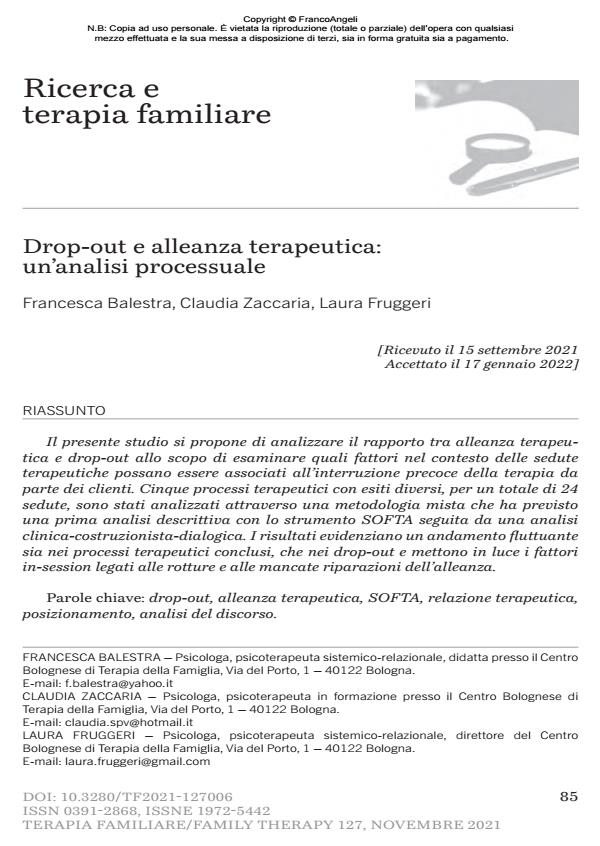Drop-out e alleanza terapeutica: un’analisi processuale
Titolo Rivista TERAPIA FAMILIARE
Autori/Curatori Francesca Balestra, Claudia Zaccaria, Laura Fruggeri
Anno di pubblicazione 2022 Fascicolo 2021/127
Lingua Italiano Numero pagine 22 P. 85-106 Dimensione file 672 KB
DOI 10.3280/TF2021-127006
Il DOI è il codice a barre della proprietà intellettuale: per saperne di più
clicca qui
Qui sotto puoi vedere in anteprima la prima pagina di questo articolo.
Se questo articolo ti interessa, lo puoi acquistare (e scaricare in formato pdf) seguendo le facili indicazioni per acquistare il download credit. Acquista Download Credits per scaricare questo Articolo in formato PDF

FrancoAngeli è membro della Publishers International Linking Association, Inc (PILA)associazione indipendente e non profit per facilitare (attraverso i servizi tecnologici implementati da CrossRef.org) l’accesso degli studiosi ai contenuti digitali nelle pubblicazioni professionali e scientifiche
Il presente studio si propone di analizzare il rapporto tra alleanza terapeutica e drop-out allo scopo di esaminare quali fattori nel contesto delle sedute terapeutiche possano essere associati all’interruzione precoce della terapia da parte dei clienti. Cinque processi terapeutici con esiti diversi, per un totale di 24 sedute, sono stati analizzati attraverso una metodologia mista che ha previsto una prima analisi descrittiva con lo strumento SOFTA seguita da una analisi clinica-costruzionista-dialogica. I risultati evidenziano un andamento fluttuante sia nei processi terapeutici conclusi, che nei drop-out e mettono in luce i fattori in-session legati alle rotture e alle mancate riparazioni dell’alleanza.
Parole chiave:Drop-out, alleanza terapeutica, SOFTA, relazione terapeutica, posizionamento, analisi del discorso.
Francesca Balestra, Claudia Zaccaria, Laura Fruggeri, Drop-out e alleanza terapeutica: un’analisi processuale in "TERAPIA FAMILIARE" 127/2021, pp 85-106, DOI: 10.3280/TF2021-127006